System Builder Marathon Q2 2015: $1600 Mini Gaming PC
Because you asked for it, we put an Intel Core i5 and an Nvidia GeForce GTX 980 into a mini-ITX case. But how does it perform compared to its larger twin?
Power, Heat, Efficiency And Value
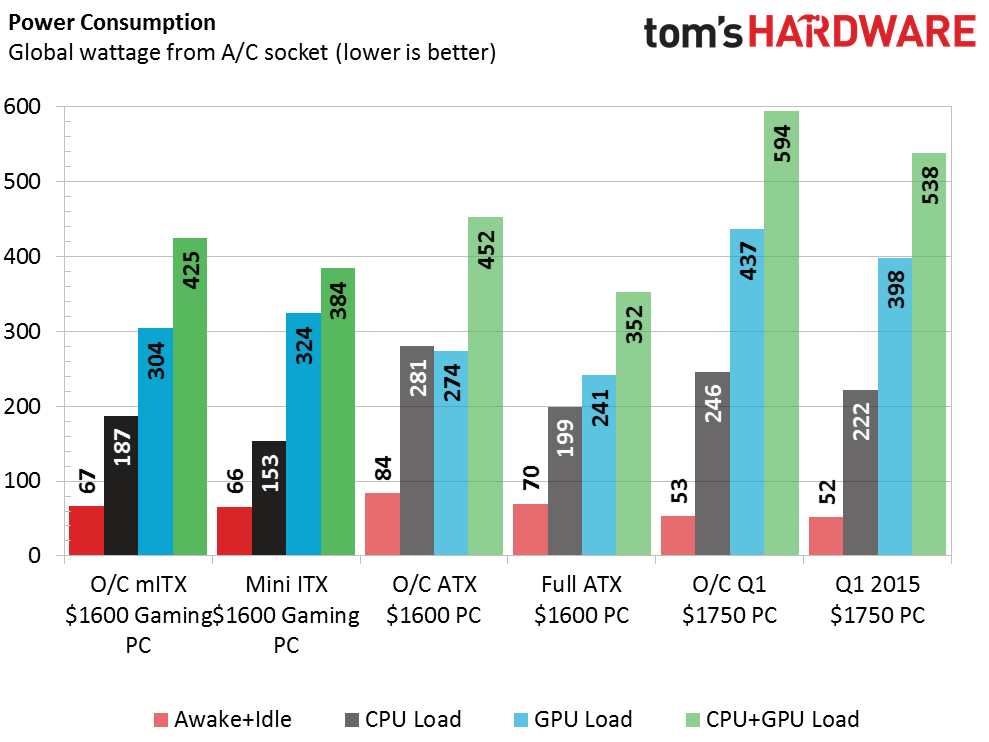
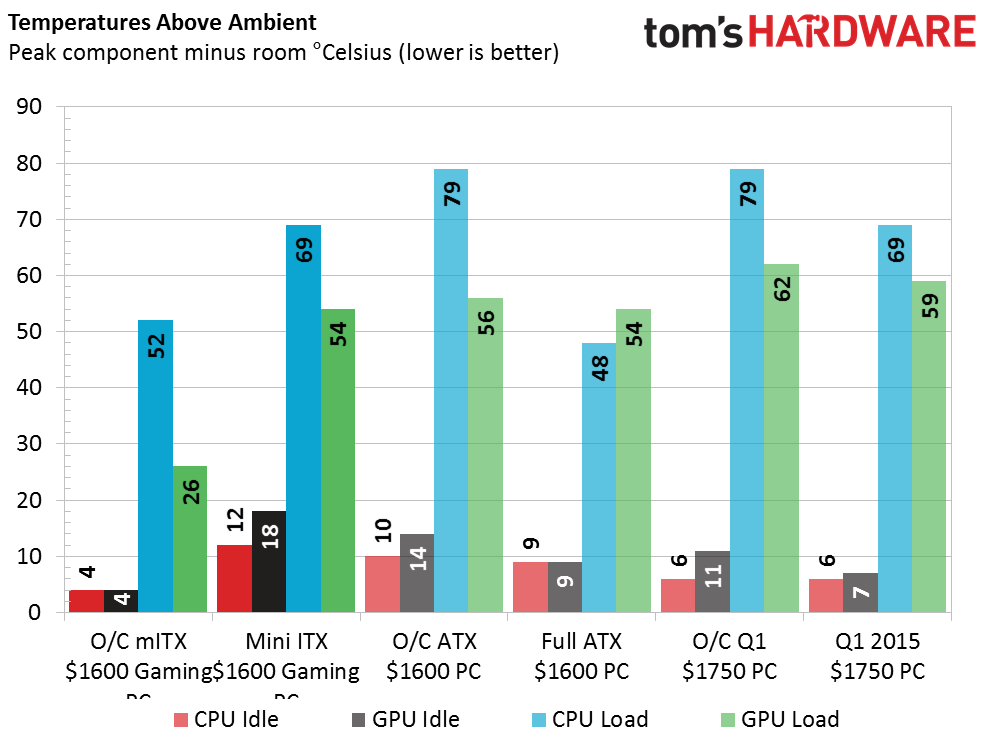
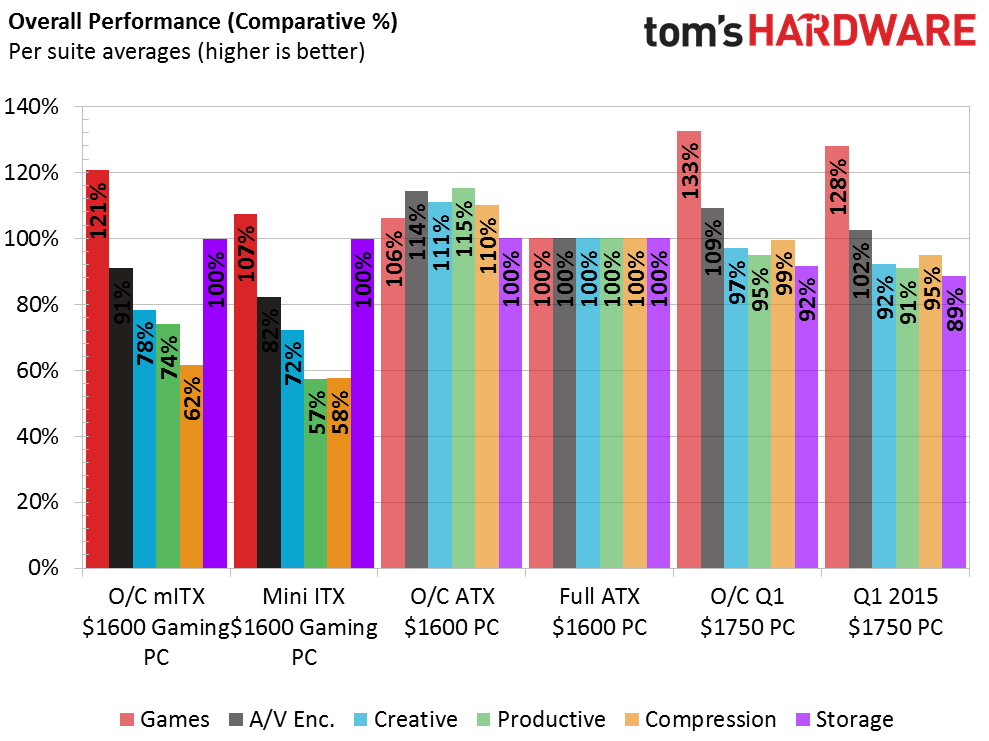
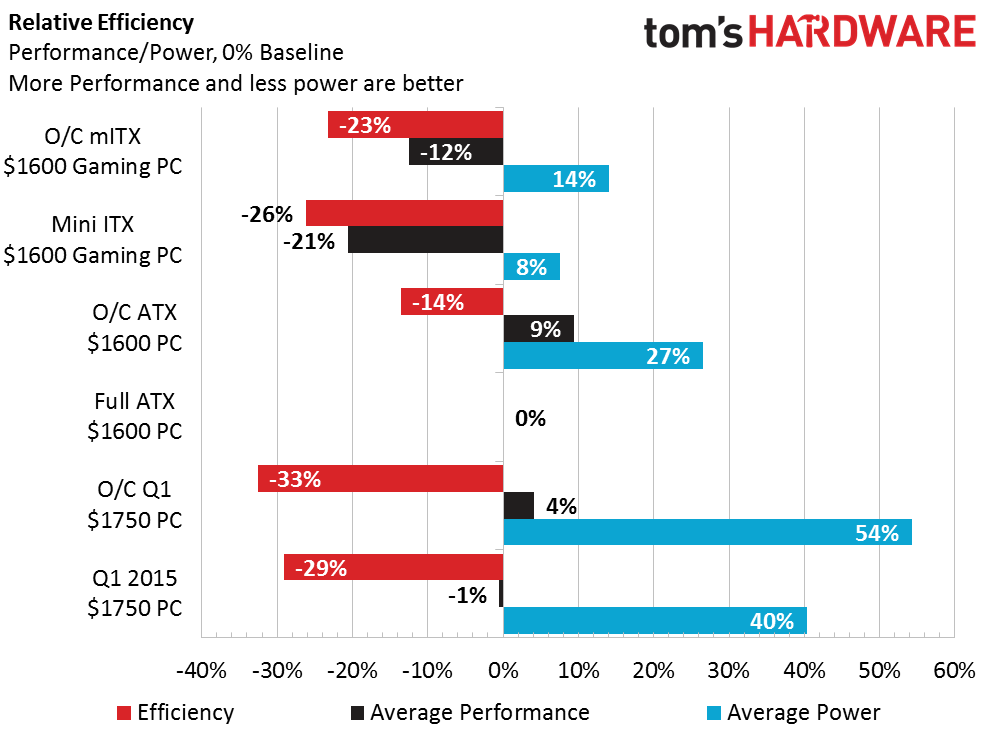
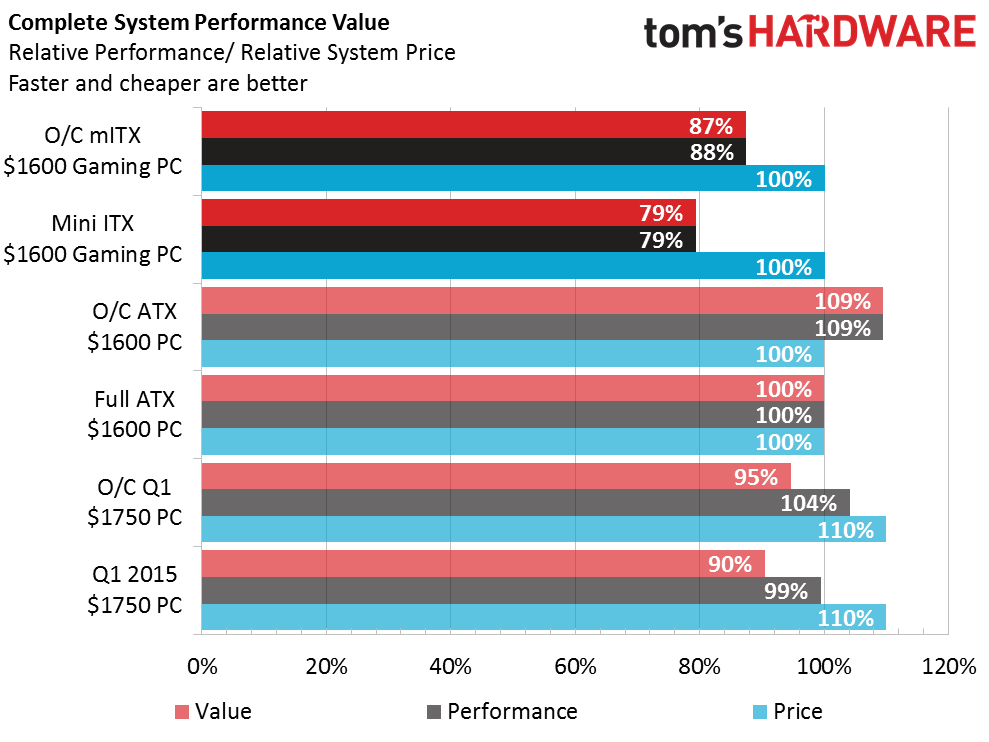
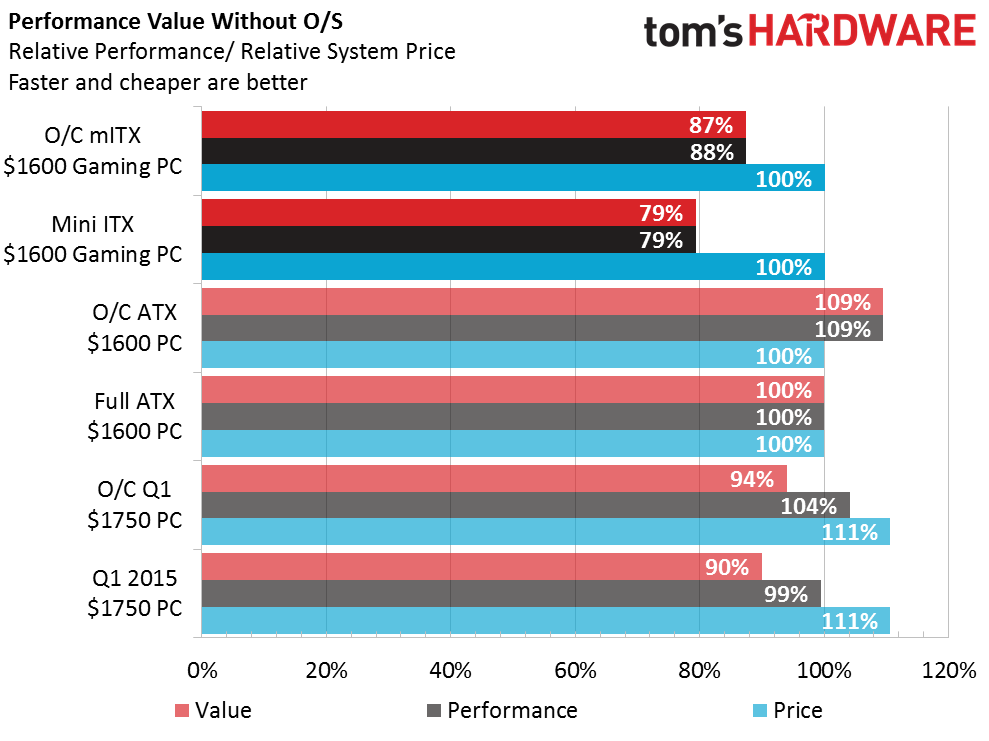
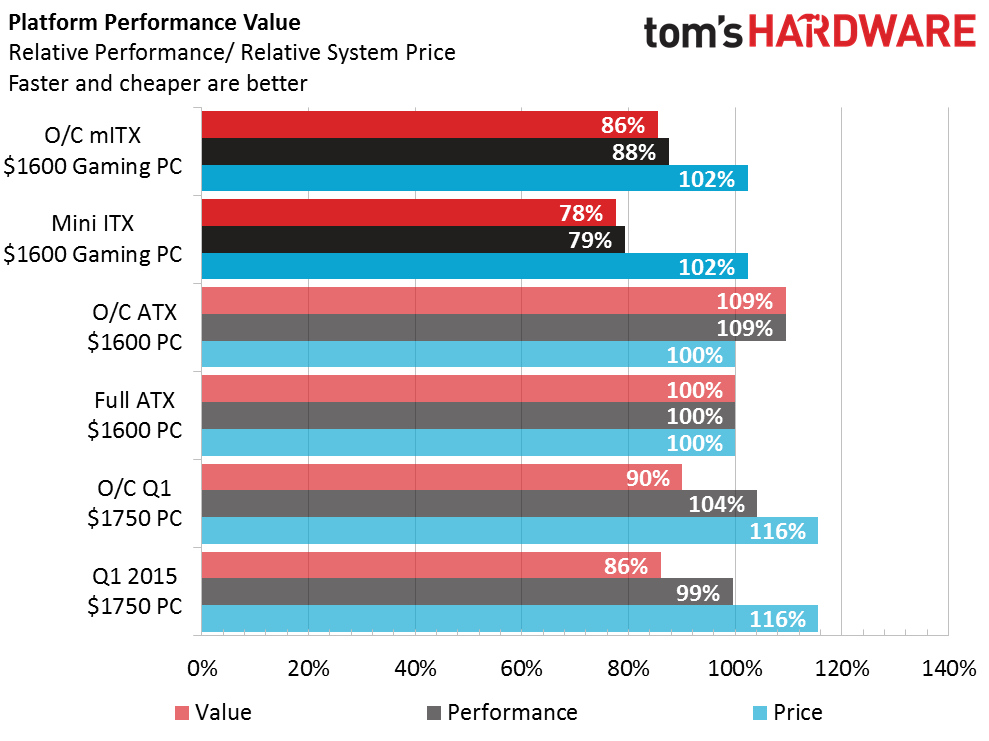
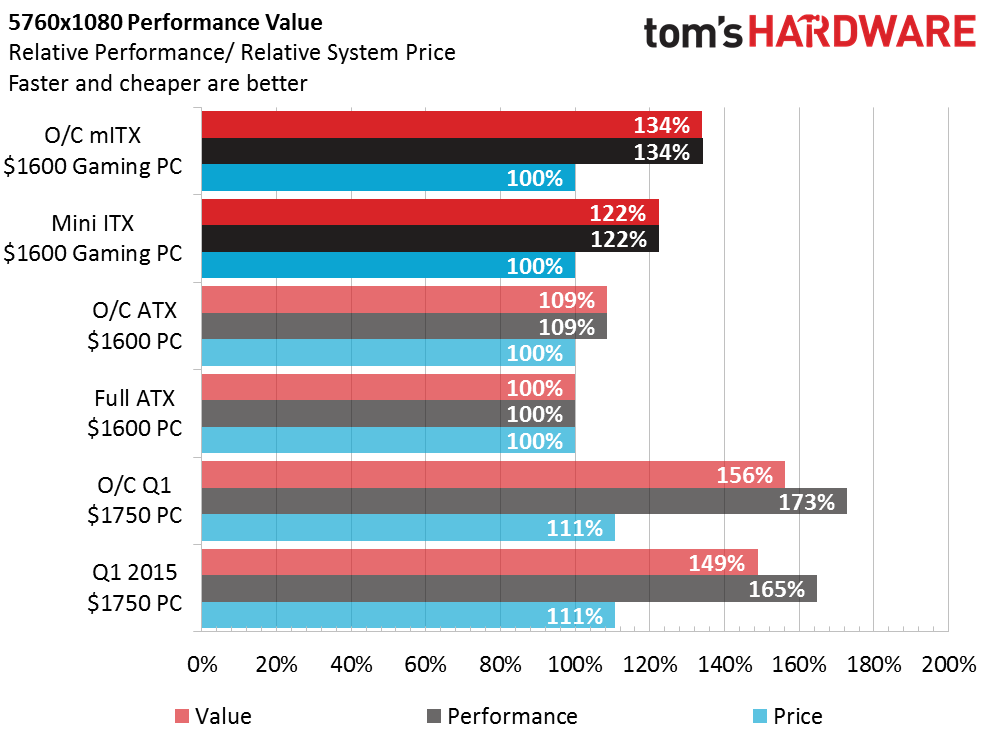
Using a combination of a programs like Prime95 and RealTemp, we get to see and measure the amount of stress a CPU encounters through its temperature. This technique came in really handy during overclocking, as we were able to see how close we were getting to the Intel CPU's 100-degree threshold.
We also get to see the power drawn by the GPU as Mini Build’s measured wattage shows us the impact of running a gaming PC in a home. It’s also interesting to note that the combined power drawn by the $1750 Q1 2015 overclocked PC is over 10 times the amount of the same machine when it’s idle.
Looking at the overall performance stats, we already know that Mini Build was working with a critical deficiency, its CPU, but that its only real saving grace is its gaming performance. You also see this similar scenario in the 5760x1080 chart at the very end.
While it's definitely not an overall high-performing home/business PC, Mini Build was designed for one thing in mind: gaming. Looking back, maybe I was too generous in going with a computer using a Core i5 processor. Had I gone with a slower i7, we would see better scores in some of the non-graphics-related charts.
Still, it was a lot of fun building both Big Build and Mini Build for you. The experience was great, and it brought back a lot of memories from this old IT guy's system building days.
MORE: Latest Systems NewsMORE: Systems in the Forums
Julio Urquidi is a Senior Staff Editor at Tom's Hardware, covering Networking, Notebooks and Systems. Follow him on Twitter and Google+.
Get Tom's Hardware's best news and in-depth reviews, straight to your inbox.
Current page: Power, Heat, Efficiency And Value
Prev Page Media, Productivity And Compression-
Onus A Rosewill RD? Really? In 2015?Reply
Having just bought this case, I'll be going over this build for details about the case, but it looks good. The other parts...well, a 980 beats my 970.
I'd have used a lesser SSD (any SSD is sufficient, vs. a mechanical drive) and likely some cheaper RAM (e.g. DDR3-1866 or -2133) for the sake of a more solid PSU.
-
vertexx It would help in all of these articles to put the component list with prices at the time of purchase. That might help fray some of the criticisms of parts choice within the budget.Reply
That said, I'm sure there will be some of the same feedback as yesterday's build. I would have stretched it to a 980ti. Sure, there would have been some compromises, but it's definitely doable for $1,600.
Within that case, it would have been good to take advantage of the available height for a full height CPU cooler.
Welcome to the shark tank! -
jtd871 That's a _lot_ of wasted space in the Mini Build case. I'd have gone with a SG13 or SG05 case with those components. The lower case volume would have allowed for the fans to keep fresh air coming into the major components with ease. This case is gonna need more fans to keep it cool and move all that air out (and avoid dead spots).Reply -
atheus ReplyThat's a _lot_ of wasted space in the Mini Build case. I'd have gone with a SG13 or SG05 case with those components. The lower case volume would have allowed for the fans to keep fresh air coming into the major components with ease. This case is gonna need more fans to keep it cool and move all that air out (and avoid dead spots).
The irony being that he mentioned mechanical issues with the limited space (repeatedly unplugging wires by accident during assembly). My thoughts aren't dissimilar, though. That mini ITX case is basically the same volume as the ATX case for the "big" build. The use of 5 case fans (only because the absolutely necessary optical drive prevented adding a 6th) is just madness to me.
I guess I just a have a different philosophy about mini ITX, but to me the whole point of it is to make a computer that is less obtrusive both in size, weight, and noise. A mini ITX build that is both large and loud with 5 case fans feels like a system that should have just been built in a micro ATX case. At the end of the day that's just the design of the Roseweill Neutron — a mini ITX case that I personally would never buy. Plus, if your case is so loud that you wouldn't reasonably want it anywhere within earshot, it barely matters if it's modestly smaller in size. -
dwatterworth This build has so many contradictions it seems. The case and motherboard can easily accommodate a larger and more importantly cheaper/more effective CPU cooler. The 256GB 850 pro seems like a total waste of funds when the 850 evo can be had for under $100 USD or step up to the 500GB 850 evo for still less than the 256gb 850 pro. For the same price as the Rosewill case you could have a bitfenix prodigy, Fractal node 304 or any of the other proven boxes. The rosewill PSU seems like a strange choice as well, a gold rated Seasonic unit is about the same price/capacity if the quoted pricing is correct.Reply
The choice of CPU cooler, case and fan configuration seems to be the most confusing part.
Maybe something like this:
http://pcpartpicker.com/p/BBb823 -
DonkeyOatie My Middle School students have built a few mITX systems this last year, and 'designed' a lot more.Reply
We would have looked at something like this:
PCPartPicker part list: http://pcpartpicker.com/p/mF29dC
Price breakdown by merchant: http://pcpartpicker.com/p/mF29dC/by_merchant/
CPU: Intel Core i5-4690K 3.5GHz Quad-Core Processor ($241.98 @ Newegg)
CPU Cooler: Silverstone NT06-PRO 74.0 CFM Sleeve Bearing CPU Cooler ($53.00 @ Newegg)
Motherboard: ASRock Z97E-ITX/ac Mini ITX LGA1150 Motherboard ($121.98 @ Newegg)
Memory: G.Skill Trident X Series 16GB (2 x 8GB) DDR3-2400 Memory ($114.99 @ Newegg)
Storage: Samsung 850 EVO-Series 250GB 2.5" Solid State Drive ($110.99 @ Newegg)
Storage: Seagate Barracuda 1TB 3.5" 7200RPM Internal Hard Drive ($49.99 @ Newegg)
Video Card: Gigabyte GeForce GTX 980 Ti 6GB Video Card ($659.98 @ Newegg)
Case: Thermaltake Core V1 Mini ITX Tower Case ($40.98 @ Newegg)
Power Supply: Antec High Current Gamer 620W 80+ Bronze Certified Semi-Modular ATX Power Supply ($59.99 @ Newegg)
Operating System: Microsoft Windows 8.1 OEM (64-bit) ($99.99 @ Newegg)
Total: $1553.87
Prices include shipping, taxes, and discounts when available
Generated by PCPartPicker 2015-07-01 10:12 EDT-0400
All from Newegg and enough money for an external DVD and an additional case fan if needed. There's also enough room for a much taller CPU cooler, and with the horizontal motherboard layout, weight does not matter much.
We have built in this case, and the 200mm fan that come stock is both quiet and effective. In spite of what the note says, the GPU will not block use of the mountings for the SSD or HDD. -
Onus The Rosewill Neutron looks to be a decent case, although large. It is not as big as the Prodigy though, which is a huge case. I'd thought about getting one, until I saw it at Microcenter. I'd like smaller than the Neutron, although I will probably put 3-4 drives in one. I'm not worried about noise from low-speed fans.Reply -
vertexx This is what I would build for a $1,600 mini-ITX gamer. I'm cheating a bit because the Silverstone SG13 is not carried by Newegg - but shame on them for that.Reply
I would actually go over budget a bit. At $1,670, you can have the 1TB Mushkin Reactor SSD.
PCPartPicker part list / Price breakdown by merchant
CPU: Intel Core i5-4690K 3.5GHz Quad-Core Processor ($241.98 @ Newegg)
CPU Cooler: Cooler Master Seidon 120V 86.2 CFM Liquid CPU Cooler ($49.99 @ Newegg)
Motherboard: ASRock Z97M-ITX/AC Mini ITX LGA1150 Motherboard ($121.98 @ Newegg)
Memory: G.Skill Ripjaws Z Series 8GB (2 x 4GB) DDR3-2400 Memory ($52.99 @ Newegg)
Storage: Mushkin Reactor 512GB 2.5" Solid State Drive ($169.99 @ Newegg)
Video Card: PNY GeForce GTX 980 Ti 6GB Video Card ($669.98 @ Newegg)
Case: Silverstone Sugo SG13B Mini ITX Tower Case ($42.38 @ Amazon)
Power Supply: XFX XTR 550W 80+ Gold Certified Fully-Modular ATX Power Supply ($81.98 @ Newegg)
Operating System: Microsoft Windows 8.1 OEM (64-bit) ($99.99 @ Newegg)
Total: $1531.26
Prices include shipping, taxes, and discounts when availableGenerated by PCPartPicker 2015-07-01 10:31 EDT-0400 -
DonkeyOatie The Z97E-ITX/AC costs about the same and has much better power phases for overclocking.Reply -
Onus Although I frequently delete alternate builds that don't follow SBM rules as being off-topic, that one acknowledges where it strays and the explanation is reasonable.Reply
I have heard that the pump in the Seidon has been implicated in a few zombie sightings as it is potentially loud enough to wake the dead.
I'd prefer a 256GB SSD in order to add a mechanical drive for bulk storage. It looks like there's enough in your budget to add one though.